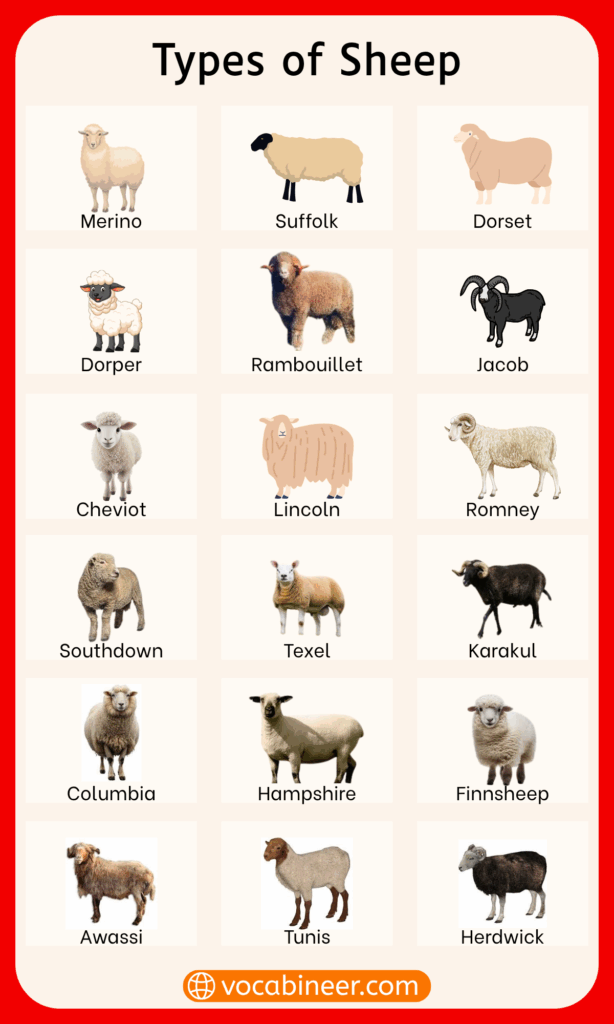Sheep are among the oldest farm animals raised by humans, and they exist in many types. Each breed has its own traits, whether it is raised for wool, meat, or both. Farmers use the names of these sheep to identify them, and knowing these names helps in agriculture and livestock studies. In this post, you will learn the different types of sheep breeds with their pictures. These names are widely used in farming, animal science, and dairy or wool production in everyday conversation.
In This Page
Common Names of Sheep Breeds
These sheep are the most recognized and commonly raised. Each one is valued for its look, strength, or products.
- Merino: Famous for very soft wool used in high-quality clothing.
- Suffolk: Strong meat breed with black face and legs, quick to mature.
- Dorset: Can breed year-round, offering lambs and fleece regularly.
- Dorper: Hardy, adaptable, and popular for meat in dry areas.
- Rambouillet: Fine wool breed with soft, elastic fleece.
- Texel: Muscular sheep producing lean and tender meat.
- Lincoln: Long wool breed with shiny, heavy fleece.
- Cheviot: Recognized by upright ears and hardy nature.
- Jacob: Rare spotted breed, sometimes with four horns.
- Katahdin: Hair sheep that sheds naturally, raised for meat.

List of Wool Sheep Breeds
Some sheep are prized for fleece used in textiles. Their names are common in the wool industry.
- Merino: Produces the softest and finest wool, widely used in garments.
- Rambouillet: Soft, strong, and elastic fleece, popular for luxury fabrics.
- Lincoln: Heavy longwool, lustrous and ideal for weaving.
- Romney: Medium fleece, versatile for clothing and carpets.
- Cotswold: Known for silky, long fleece, often used by hand spinners.
- Bluefaced Leicester: Valued for its fine, curly wool in knitting.
Meat Sheep Types and Names
These sheep grow fast and produce high-quality lamb meat. Farmers often raise them for quick market sales.
- Suffolk: Well-known for flavorful and tender meat.
- Dorper: Hardy breed that grows quickly for meat production.
- Texel: Lean meat with excellent muscle development.
- Dorset: Versatile, producing both good meat and steady lambs.
- Hampshire: Large breed, similar to Suffolk, excellent for meat.
- Charollais: French breed known for tender meat and rapid growth.
Dual Purpose Sheep Breeds List
Some breeds offer both quality wool and meat, making them useful for mixed farming.
- Columbia: Large frame, heavy fleece, and reliable meat production.
- Corriedale: Produces medium wool and tender meat, adaptable to climates.
- Polypay: American breed, efficient for both lambs and wool.
- Finnsheep: High fertility, producing lambs often, with decent fleece and meat.
Hair Sheep Types
Hair sheep shed naturally, making them easy to maintain in warm regions.
- Katahdin: Popular for meat and parasite resistance.
- Barbados Blackbelly: Hardy sheep suited for tropical climates.
- St. Croix: Originating in the Virgin Islands, known for resilience.
Rare Sheep Breeds and Names
These sheep are less common but important for history, tradition, or unique looks.
- Jacob: Distinct spotted wool and often four horns.
- Shetland: Small and hardy, with fine wool in natural colors.
- Navajo-Churro: Ancient wool breed, linked to Native American herding.
- Soay: Primitive sheep from Scotland, small and hardy.
- Manx Loaghtan: Isle of Man sheep with multiple horns, very rare.
Regional Types of Sheep
Some sheep are strongly linked to their homeland, often tied to traditional uses.
- Scottish Blackface: Hardy sheep with coarse wool used for tweed.
- Awassi: Middle Eastern breed, valued for high-fat milk in cheese.
- East Friesian: Excellent dairy breed, produces large amounts of milk.
- Valais Blacknose: Swiss mountain sheep, iconic with black face and nose.
- Clun Forest: British breed with dark face, adaptable with medium wool.
Conclusion
Sheep come in many types, each with its own strengths and uses. From fine wool breeds like Merino and Rambouillet, to hardy meat breeds such as Suffolk and Dorper, and even rare kinds like Jacob and Valais Blacknose, every name has a place in farming history. Learning the different types of sheep breeds with their pictures helps us understand how they contribute to wool, meat, and dairy production around the world.
FAQs about Types of Sheep Breeds
There is no single best breed. Many dual-purpose breeds such as Columbia, Corriedale, and Polypay provide both good fleece and quality meat, depending on climate and farm goals.
There are more than 200 recognized sheep breeds globally, and some estimates suggest over 1,000 distinct types when including local and rare varieties.
Sheep breeds are generally grouped by production traits: fine wool, long wool, medium wool, meat, dual-purpose, hair, and dairy types.
Yes. Hair sheep breeds like Katahdin and St. Croix grow a hair coat that sheds naturally in warmer seasons, so they do not need shearing.
The East Friesian is the most common dairy sheep breed, known for high milk yield. Other notable milk-producing breeds include Lacaune and Awassi.
Read More




